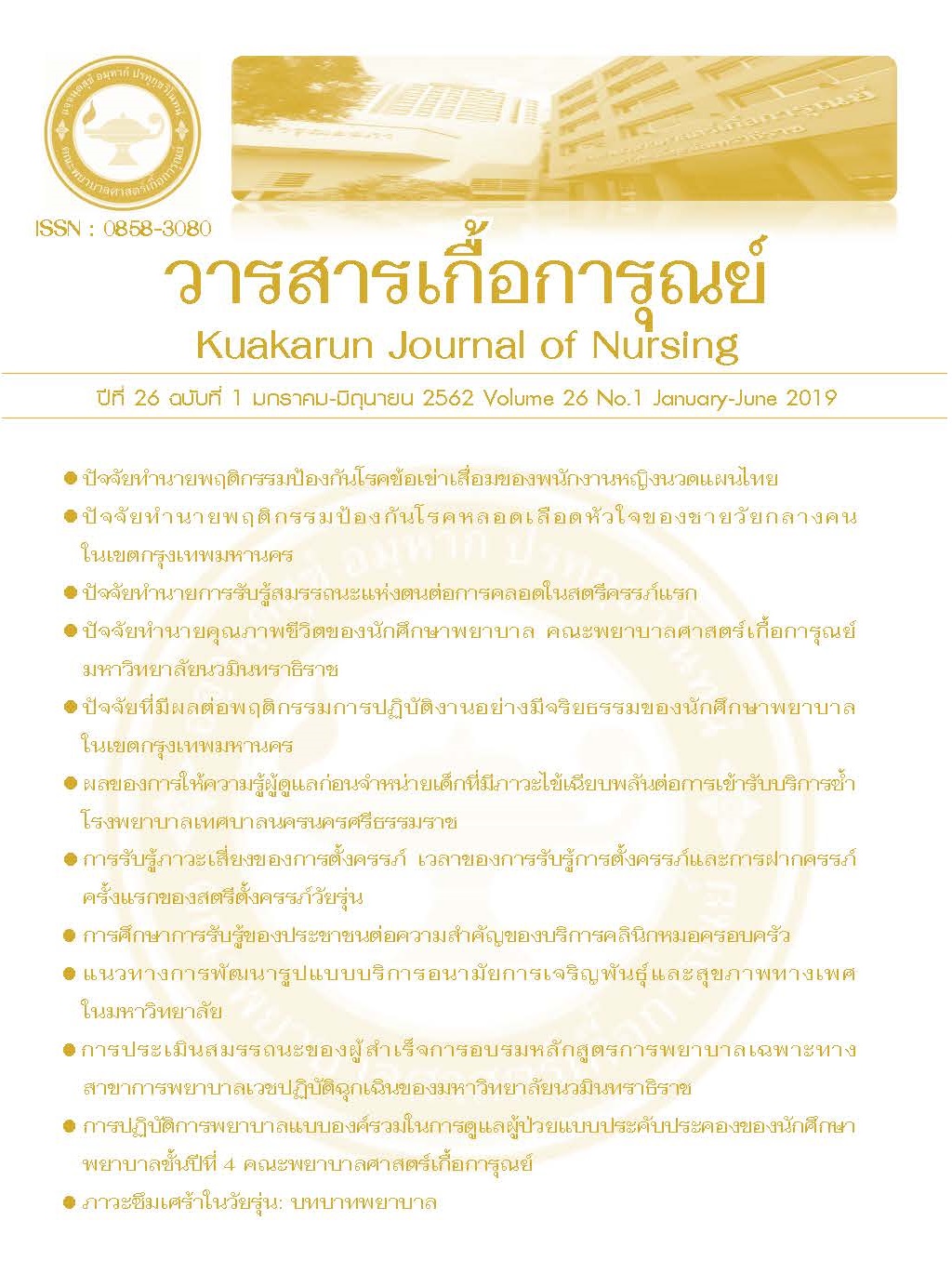Competency evaluation of the Trainees in the Nursing Specially in Emergency Nurse Practitioner Program of Navamindrathiraj University
Main Article Content
Abstract
The development of emergency nursing competencies is important to encourage nurses to improve their knowledge, skills and abilities of emergency practice. However, there was little research conducted to evaluate the long-term competency of emergency nurses. The present descriptive study aimed to investigate emergency nursing competencies of trainees who were trained in the Nursing Specialty in Emergency Nurse Practitioner Program of Navamindrathiraj University. The study sample consisted of 83 nurses who were 38 trained nurses, 25 emergency nurses, and 20 nurse supervisors. Data collection was undertaken using the questionnaire on emergency nursing competencies, validated by means of the Index of Item Objective Congruence of 0.8 and reliability determined with Cronbach’s alpha coefficient of 0.9. Data were analyzed by descriptive statistics, as well as one-way ANOVA and one-way repeated measure ANOVA.
The results revealed that: (1) The mean score of overall emergency nursing competencies assessed before the training was at a moderate level ( = 3.47,
S.D = 0.49), with the competency to perform life support having the highest mean score ( = 3.57, S.D = 0.61. After the training and one more after the training ended, the mean score of overall emergency nursing competencies was at a high level
= 4.45, S.D = 0.35 and
= 4.27, S.D = 0.24, respectively), with the competence to perform life support having the highest mean scores (
= 4.53, S.D = 0.38 and
= 4.38, S.D = 0.36, respectively, followed by the competency to provide nursing intervention (
= 4.44, S.D = 0.43 and
= 4.29, S.D = 0.61, respectively) and the competency to screen and care for emergency patients (
= 4.44, S.D = 0.47). In addition, at three months after the training, the mean score of overall nursing competencies was at a highest level (
= 4.55, S.D = 0.36), with the competency to perform life support and the competency to provide nursing intervention having the highest mean scores (
= 4.78, S.D = 0.36 and
= 4.67, S.D = 0.41, respectively. When exploring the trainees’, emergency nurses’, and nurse supervisors’ opinions at one and three months after the training ended, it was found that the overall nursing competencies of emergency nursing who completed the training were at a high level (
= 4.26, S.D = 0.35 and
= 4.41, S.D = 0.38, respectively). (2) There was a statistically significant difference of the emergency nursing competency determined before training, immediately after training, one month after training, and three months after training when analyzing trainees’ opinions (P < 0.05). (3) There was no statistically significant difference among the opinions of trained nurses, emergency nurses, and nurse supervisors toward the emergency nursing competencies in all domains (P < 0.05).
Based on the study results, it is recommended that evaluation of emergency nursing competency should be followed up periodically to further develop the Emergency Nurse Practitioner Program and to retain these competencies. Also, the performance of the trainees should be tracked by means of qualitative research to obtain more specific and detailed data necessary for the improvement of the quality of nursing care provided to emergency patients.
Article Details
References
มาลี คำคง (2557).การพัฒนาพยาบาลสู่คุณภาพการบริการในงานอุบัติเหตุ-ฉุกเฉิน. วารสารเครื่อข่ายวิทยาลัยพยาบาลและการสาธารณสุขภาตใต้, 1(1), 71-84.
ปรียาวรรณ วิบูลย์วงศ์ และธนาภา ฤทธิวงษ์ (2560). การประเมินสมรรถนะของผู้สำเร็จการอบรมหลักสูตรการพยาบาลเฉพาะทางสาขาการพยาบาลฉุกเฉิน วิทยาลัยพยาบาลบรมราชชนนี กรุงเทพ. วารสารวิทยาลัยพยาบาลบรมราชชนนี กรุงเทพ, 33(2), 135-145.
สถาบันการแพทย์ฉุกเฉินแห่งชาติ (2558). รายงานประจำปี 2558 สถาบันการแพทย์ฉุกเฉินแห่งชาติ. นนทบุรี: สถาบันการแพทย์ฉุกเฉิน.
ศิริอร สินธุรวมพร คงกำเนิด และกุลระวี วิวัฒนชีวิน (2557) การศึกษาปัจจัยที่มีความสัมพันธ์กับการปฏิบัติการการแพทย์ฉุกเฉินของพยาบาลวิชาชีพ. วารสารวิทยาลัยพยาบาลบรมราชชนนี นครราชสีมา, 20 (2). 33-45.
Chen, S,S., Chen, J.C., Ng, C.J., Chen, P.L., Lee, P.H., & Chang, W.Y. (2010). Factors that influence the accuracy of triage nurses' judgement in emergency departments. Emergency Medicine Journal, 27(6), 451-5.
Gerdtz, M. F., Weiland, T. J., Jelinek, G. A., Mackinlay, C., & Hill, N. (2012). Perspectives of emergency department staff on the triage of mental health‐related presentations: Implications for education, policy and practice, Emergency medicine Australia, 24(5), 492-500.
KozaMani A., Kapadochos, T., & Kadda, O. (2012). Factors that influence nursing staff attitudes toward initiating CPR and in nursing an automatic external defibrillator when outside of a hospital. Journal of Health Science, 6(1), 88-101
World health organization. (2013). Global Status Report on the Road Safety. Retrieve from https://www.who.int/violence_injury_prevention/road_safety_status/2013/en/

